Momentum Oscillators
AC DC Histogram
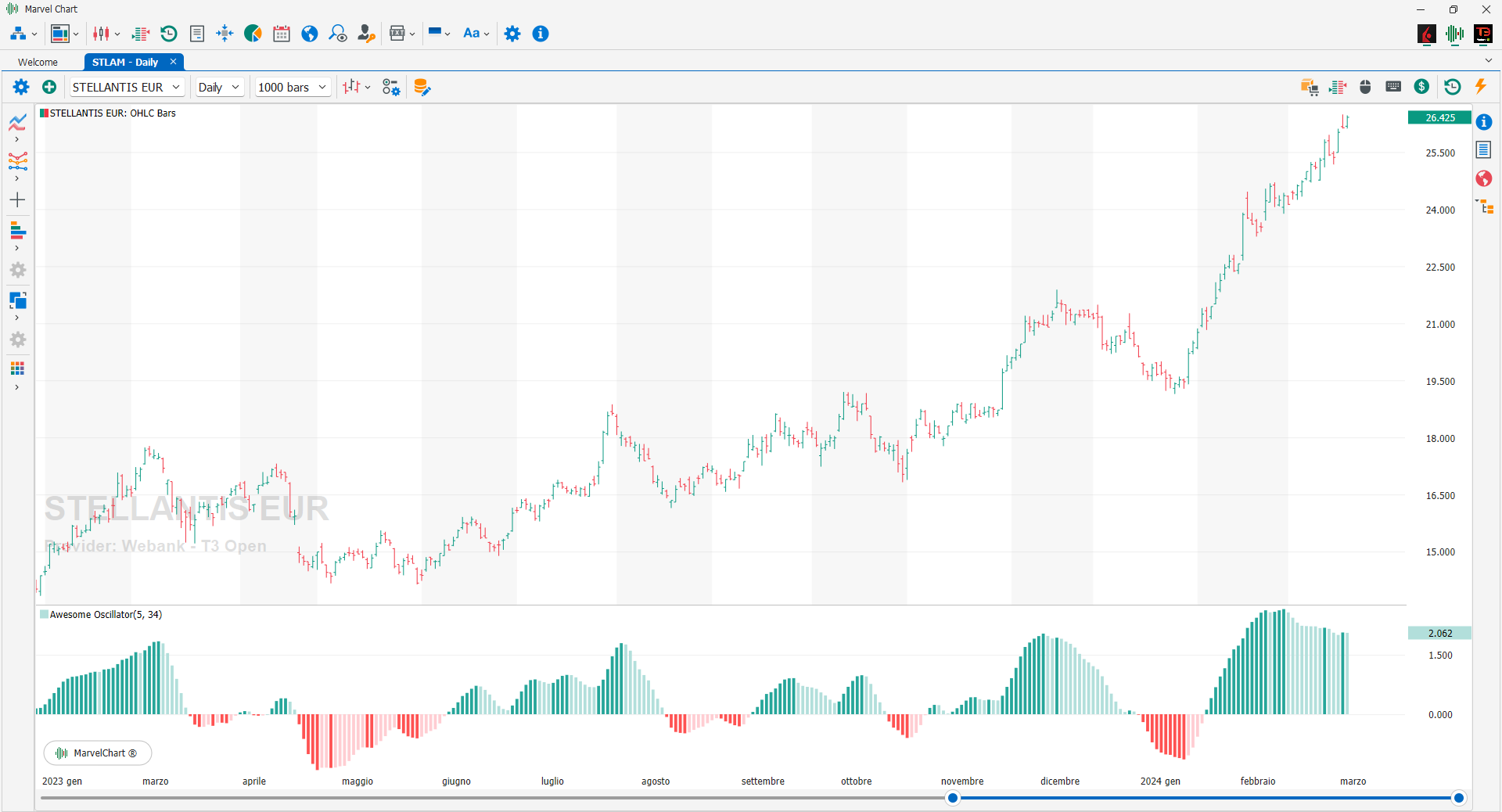
The AC DC Histogram indicator, developed by Bill Williams, is a momentum indicator that helps traders identify potential trend reversals or continuations by visualizing the acceleration or deceleration of the market. It's derived from the Awesome Oscillator (AO) and is represented as a histogram fluctuating around a zero line.
Purpose
The AC DC Histogram aims to measure the acceleration or deceleration of market momentum.
Construction
It's based on the Awesome Oscillator, which itself is calculated using moving averages.
Visual Representation
The indicator is displayed as a histogram, with positive values (above the zero line) suggesting bullish momentum and negative values (below the zero line) indicating bearish momentum.
Interpretation
Trend Reversals
When the histogram crosses above the zero line, it can signal a potential bullish reversal, and when it crosses below, a potential bearish reversal.
Momentum Strength
Larger bars on the histogram indicate stronger momentum, while smaller bars suggest weakening momentum.
Divergence
Like other oscillators, divergence between the histogram and price action can be a significant signal. For example, if the price makes higher highs but the histogram makes lower highs, it could indicate a weakening uptrend and a potential reversal.
Relation to MACD
While the AC DC Histogram is distinct from the MACD (Moving Average Convergence Divergence), both indicators use histograms to represent momentum and can be used to identify similar signals.
In essence, the AC DC Histogram provides traders with a visual tool to assess the strength and direction of market momentum, helping them identify potential trading opportunities.
Awesome Oscillator

The Awesome Oscillator is an indicator used to measure market momentum. This oscillator calculates the difference between 34-period and 5-period simple moving averages. The Simple Moving Averages used are not calculated using the close price but rather the average value of each bar. The Awesome Oscillator is generally used to corroborate the trend or to anticipate possible reversals.
Chaikin Money Flow
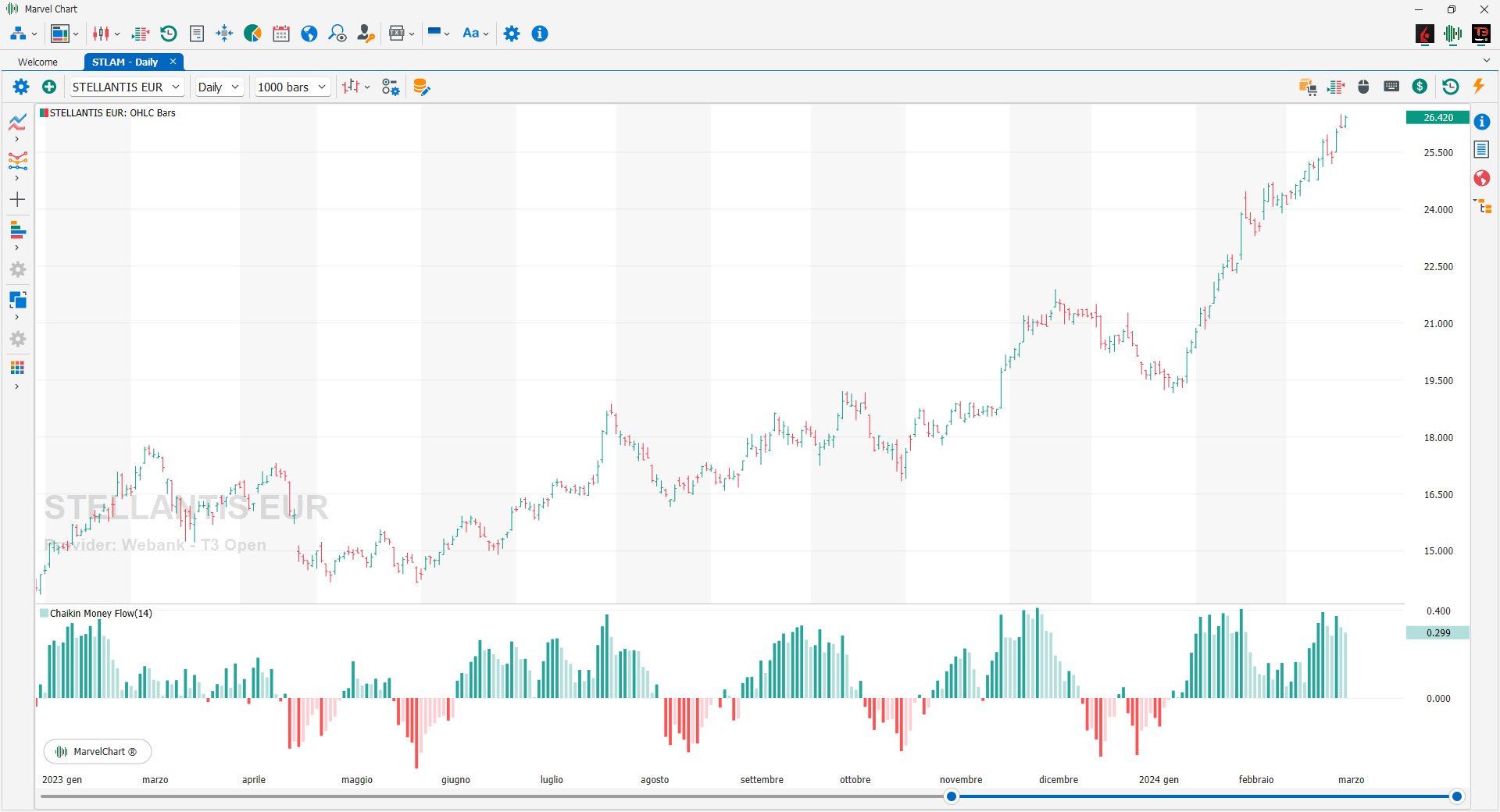
Developed by Marc Chaikin, the Chaikin Money Flow is an oscillator calculated based on the daily readings of the accumulation/distribution line. As with the A/D line, the pressure of buyers and sellers is also determined for the Chaikin oscillator based on the position of the close with respect to the maximum and minimum. In fact, there is positive pressure, or accumulation, if the close is in 50% of the positive range; instead, there is negative pressure, or distribution, if the close is in 50% of the negative range. In general, the Chaikin Money Flow is bullish when it is positive and bearish when it is negative. This indicator generates bullish signals that a financial instrument is accumulating based on three factors: The first and most obvious factor is whether the Chaikin Money Flow reading is greater than zero: it is a buy indication when the indicator is positive. The second factor is the duration of the reading, how long the oscillator has been positive: the longer the oscillator remains above zero, the more evidence there is that the financial instrument is in a sustained accumulation phase; long periods of accumulation or buying pressure are bullish indications and indicate that sentiment remains positive. The third factor is the strength of the oscillator: not only should the oscillator remain above zero, but it should also be able to increase and reach a certain level; the more positive the reading, the more evidence there is of buying and accumulation pressure.
Chande Momentum Oscillator
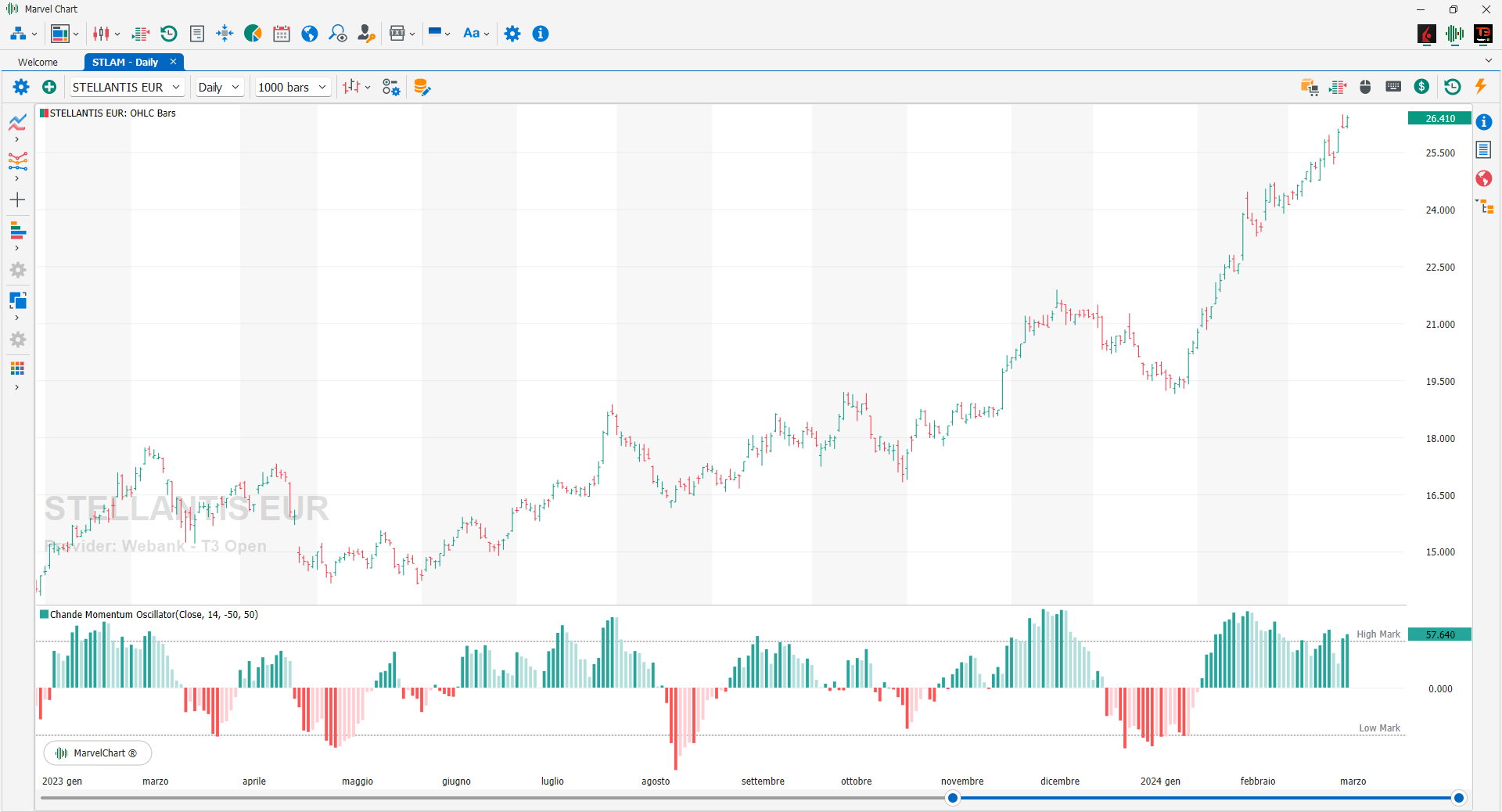
The Chande Momentum Oscillator is a pure momentum oscillator that identifies short-term excesses of market momentum. It is a variant of the RSI, from which it differs in that the Chande Momentum Oscillator measures momentum directly (in the numerator of the formula it includes the momentum of positive and negative days, while the RSI uses only the momentum of positive days in the numerator). The Chande Momentum Oscillator does not use damping mechanisms within its formula, so it does not smooth out short-term excesses of momentum, while the RSI performs its calculations on damped data. The scale of the Chande Momentum Oscillator ranges from -100 to +100, so you can see the momentum at a glance (above or below zero), while with RSI, which has a scale of 0 to 100, the value 50 should be used as the limit of the momentum.
Coppock Curve
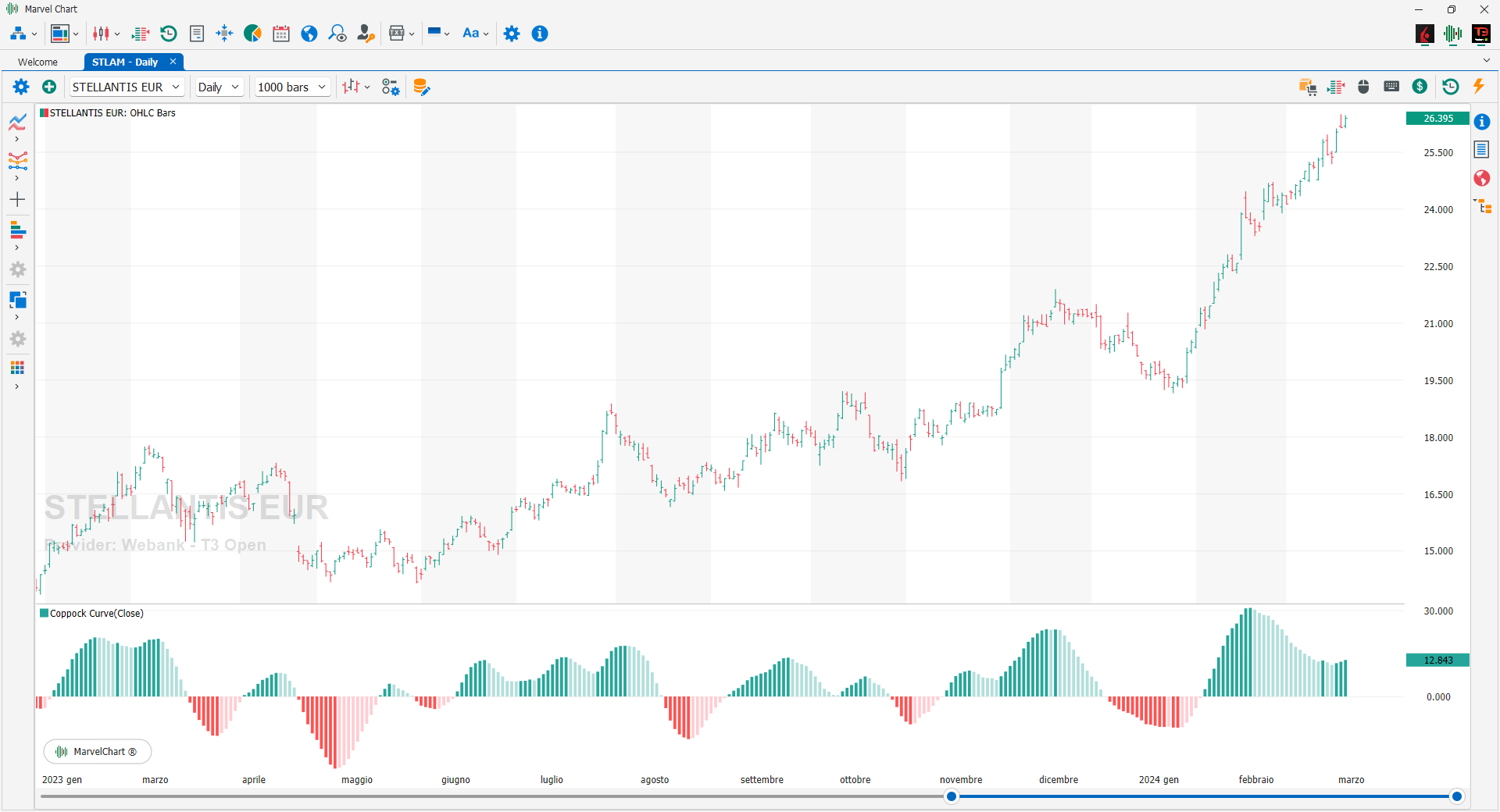
The Coppock Curve is a momentum indicator designed for long timeframes created by Edwin Sedgwick Coppock way back in 1962. It is an indicator that follows the trend and generates buy signals when it becomes negative, breaking the zero line downwards. Due to its construction, it is an indicator that does not show a new trend in a reactive way but rather when it is well consolidated. Coppock created this indicator for the SP 500 and Dow Jones Industrial indices, so it is advisable to use it on indices rather than on stocks or commodities. In fact, in the case of raw materials, Coppock advises against using them because the lows of these instruments generally have a rounded shape, while on other instruments the lows have a pointed shape.
DeMarker Oscillator
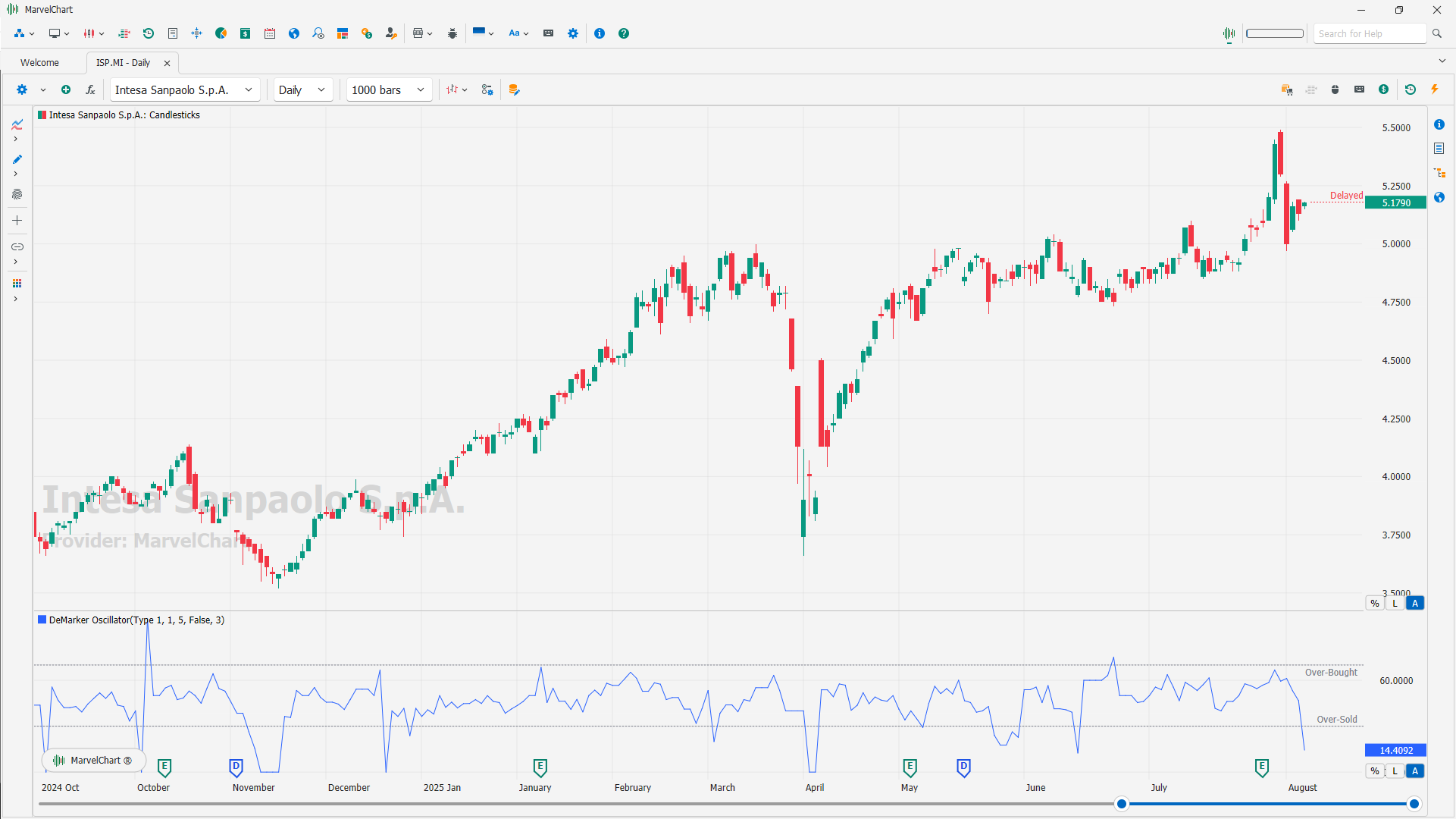
The DeMarker Oscillator (DeM) indicator is a technical analysis tool used to assess buying and selling pressure in a market, helping traders identify potential trend reversals. It's an oscillator, meaning it fluctuates between a range, typically 0 and 1, with overbought and oversold levels marked at 0.7 and 0.3, respectively. The indicator helps traders gauge whether a market is overbought (price may fall) or oversold (price may rise).
How it works
The DeMarker Oscillator indicator compares the recent high and low prices of an asset with those from the previous period to measure buying and selling pressure.
Overbought and Oversold Levels
When the DeM value is at or above 0.7, it suggests the market is overbought, potentially signaling a price decline. Conversely, a value at or below 0.3 suggests an oversold market, indicating a possible price increase.
Divergence
The indicator can also be used to identify divergences, where the price moves in one direction while the DeM moves in the opposite direction, potentially signaling a trend reversal.
Usage
It's generally recommended to use the DeMarker indicator in conjunction with other technical analysis tools and price action analysis for a more comprehensive view of the market.
Customization
Traders can adjust the period setting (default is usually 14) to customize the indicator's sensitivity. A shorter period (e.g., 6-9) might be preferred for day trading, while longer periods (e.g., 20-30) could be more suitable for longer-term analysis.
De-Trended Price Oscillator
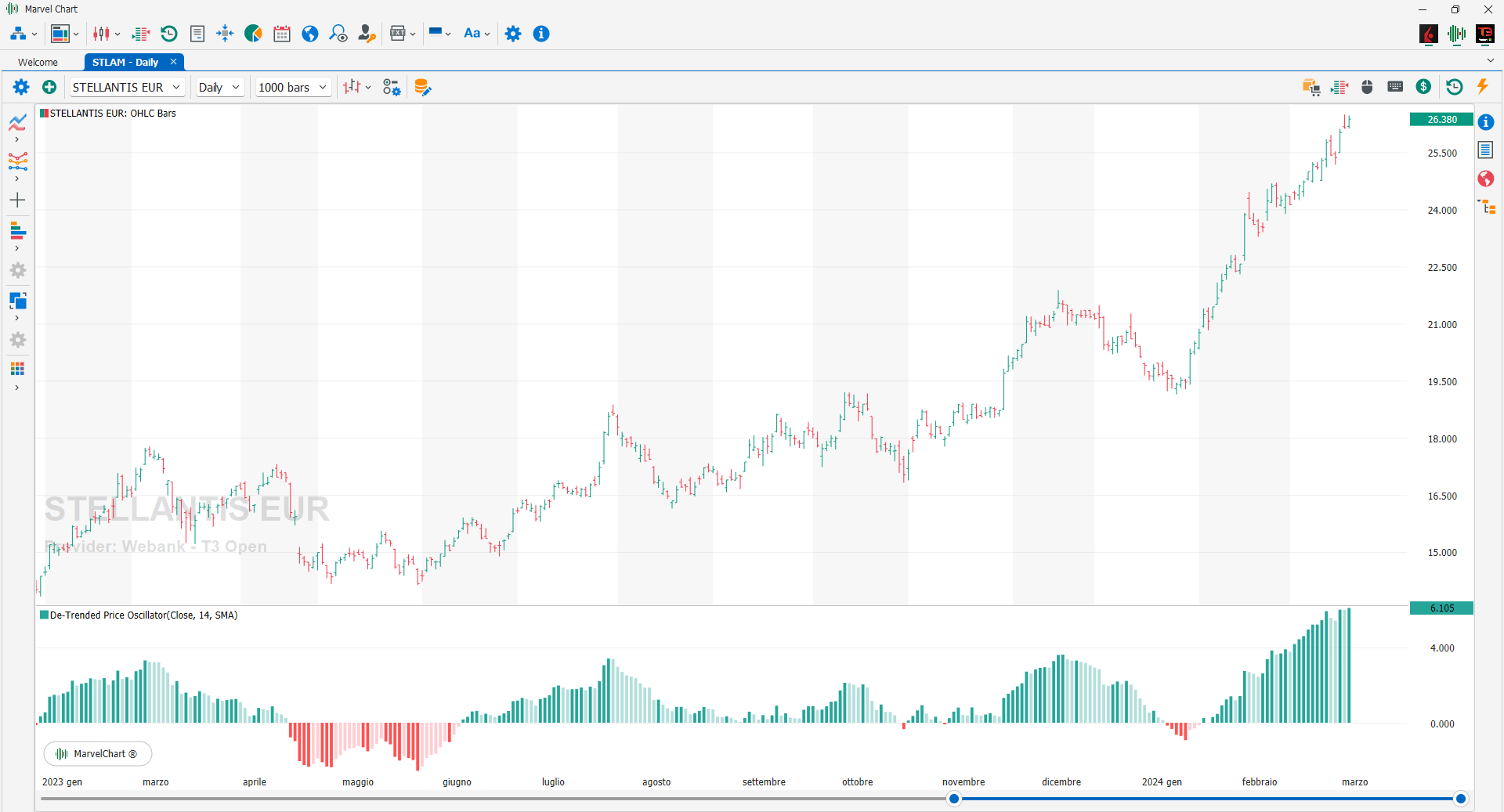
The Detrended Price Oscillator is an indicator that allows you to identify long-term cycles starting from the analysis of short-term cyclical components. The indicator calculates the difference between the daily price and the respective moving average shifted back in time ((Periods * 0.5) +1). The standard interpretation is very simple: a BUY signal is generated when the Detrended Price Oscillator goes from negative to positive, on the contrary a SELL signal is generated when the Detrended Price Oscillator goes from positive to negative.
DT Oscillator
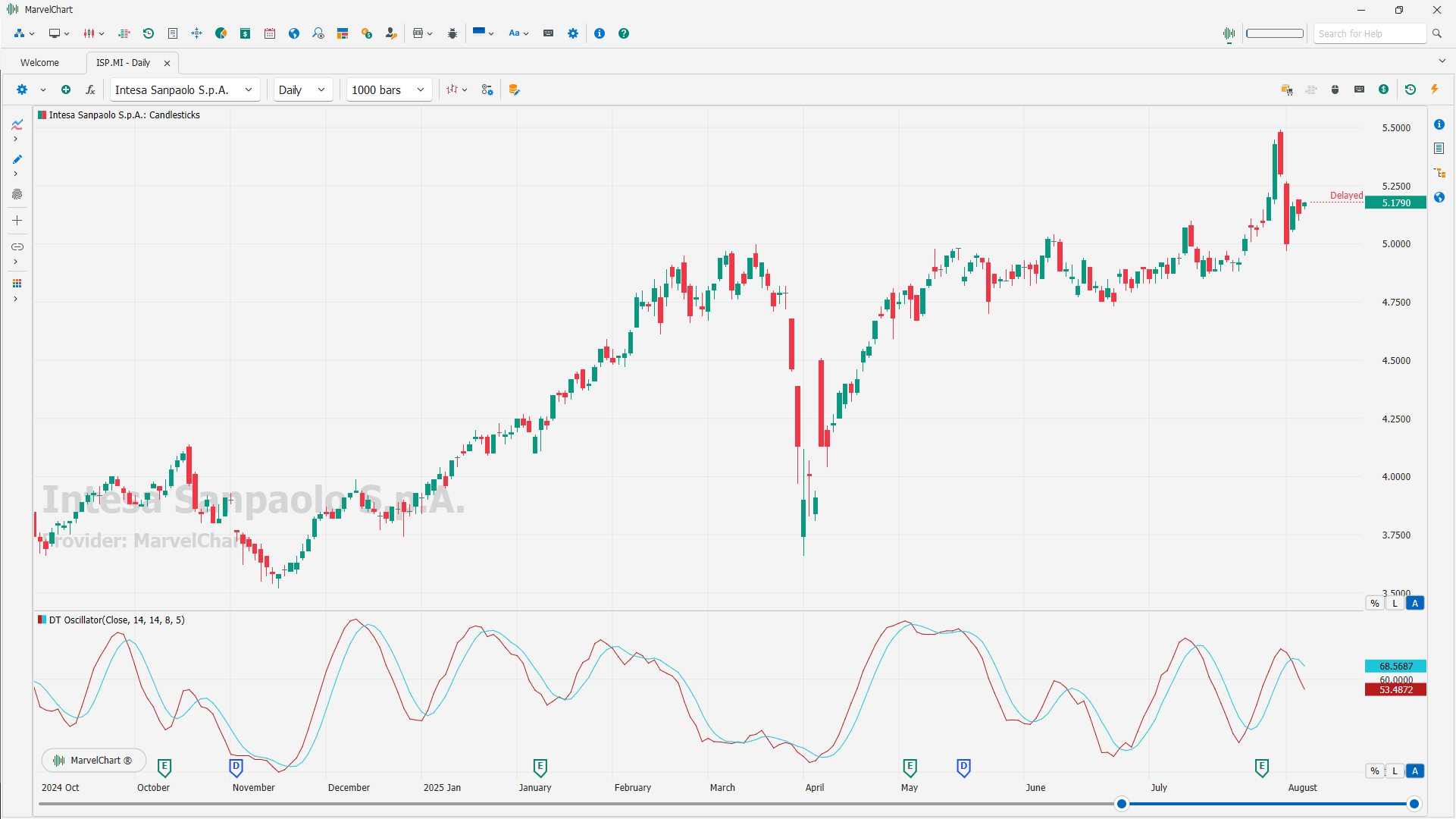
The DT Oscillator is a technical indicator that combines elements of the Stochastic Oscillator and the Relative Strength Index (RSI), with added smoothing and volatility components. It is used to identify momentum highs and lows and is considered useful for identifying market cycles and momentum in various markets and timeframes. It is often used in conjunction with other indicators and trading strategies.
Key Features
Stochastic and RSI Combination
The DT Oscillator uses the calculations of both the Stochastic Oscillator and the RSI to analyze price momentum.
Dual Timeframe and Lookback
It can be applied across multiple timeframes and incorporates a dual lookback period, allowing for more comprehensive analysis of price action.
Smoothing and Volatility
The indicator incorporates smoothing techniques and a volatility component to help filter out noise and identify potential trading opportunities.
Overbought/Oversold Levels
Like other oscillators, the DT Oscillator helps identify overbought and oversold conditions, suggesting potential reversal points.
How it's used
Momentum Identification
The DT Oscillator helps traders identify when prices are trending strongly (either up or down) and when momentum may be weakening.
Multiple Timeframe Analysis
By applying it to different timeframes, traders can identify consistent momentum signals across multiple perspectives.
Trading Signals
The indicator can be used to generate buy and sell signals based on overbought/oversold conditions, crossover of moving averages, or other specific rules within a trading strategy.
Summary
Fractal Chaos Oscillator
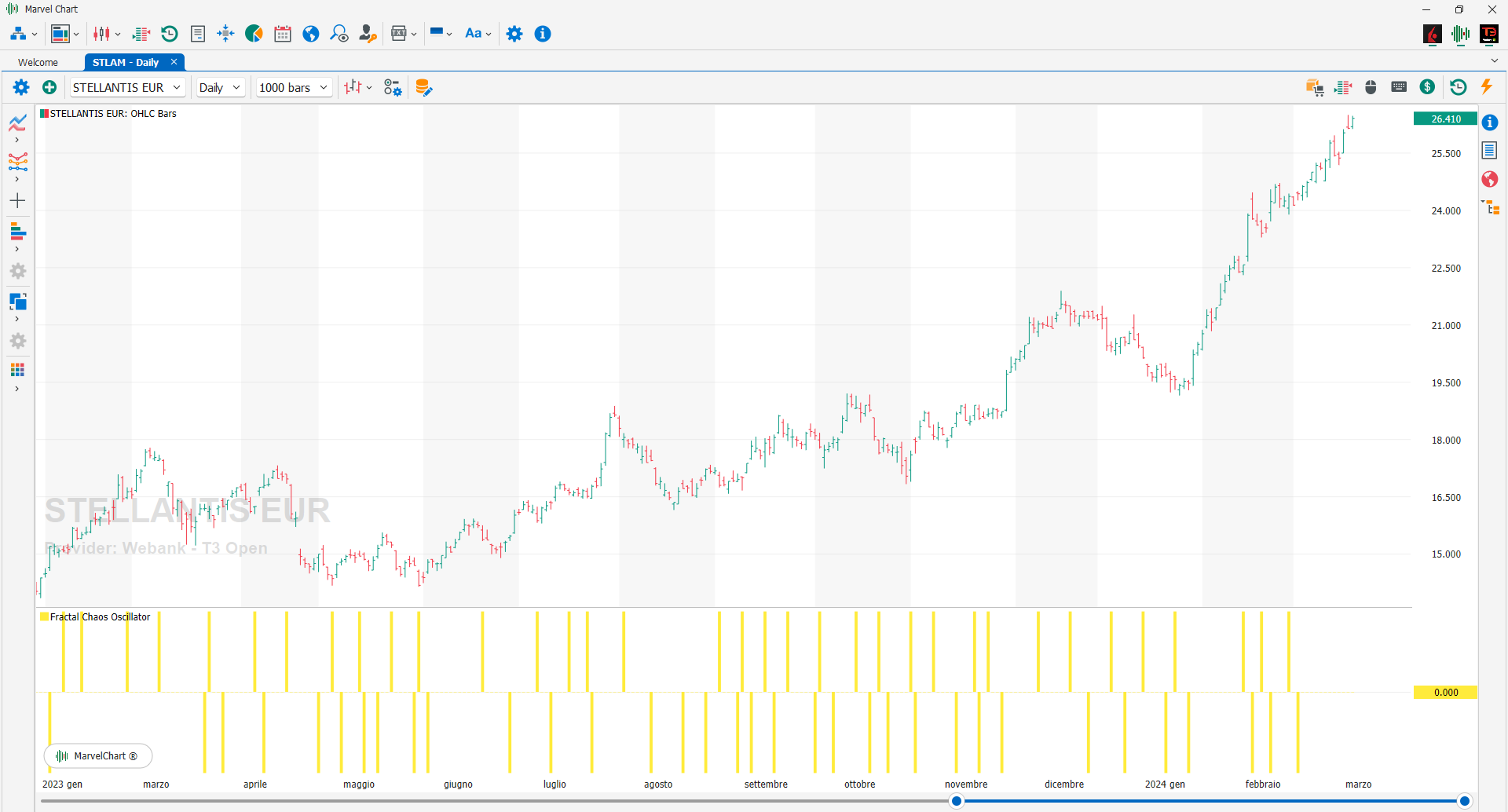
Widely used in mathematics, fractals are related to chaos theory and abstract mathematics and can also be useful applied to the financial market, since the market itself is dynamic and non-linear. In trading, fractals are defined in their literal meaning, that is, used to divide larger trends into simple and predictable patterns, to predict market reversals and to determine repetitive samples. The value of the Fractal Chaos Oscillator is calculated as the difference between the most subtle movements of the market. In general, its value is between -1,000 and 1,000. The higher the value of the Fractal Chaos Oscillator, the more we can say we are following a certain trend. Fractal Chaos Bands and Fractal Chaos Oscillator have similar names and in fact the two indicators are relatively similar in their interpretation. Both reflect the market trend, but in different ways. On a chart, Fractal Chaos Bands look like a band, composed of two lines that pass through the highest and lowest market values in that period of time. The flatter the band, the more unstable the market, while the more chaotic the band appears, the more the market is trending.
Internal Bar Strength
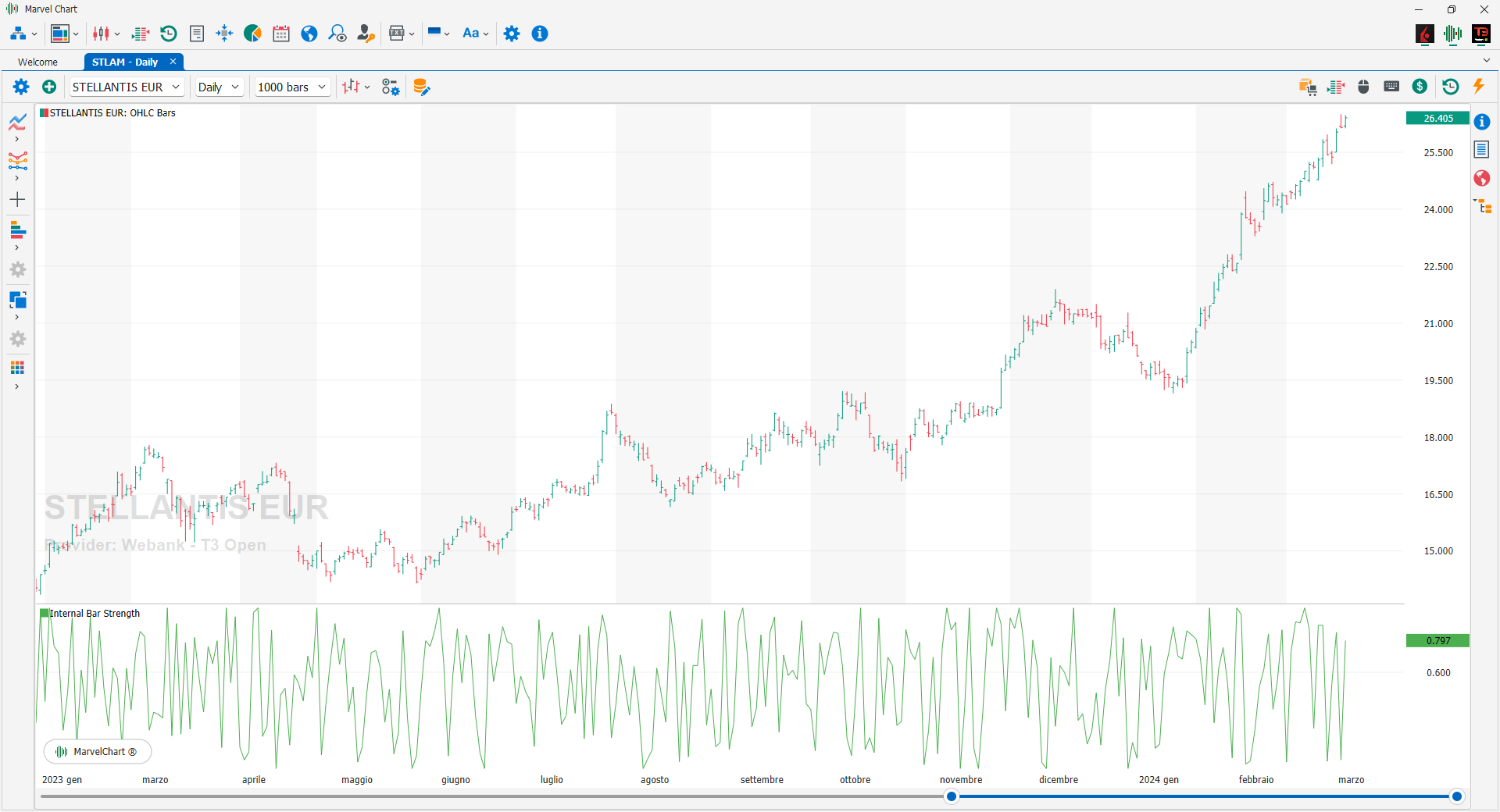
Internal Bar Strength is an idea that has been around for some time and is based on the position of the day's Close in relation to the day's range: it takes a value of 0 if the close price is the lowest price of the day, and 1 if the close price is the highest price of the day. The essence of the idea is that stocks that close at the lower end of the daily range, with an IBS lower than, say, 0.2, will tend to recover the following day, while stocks that close in the top quintile will often lose value the following session.
Know Sure Thing
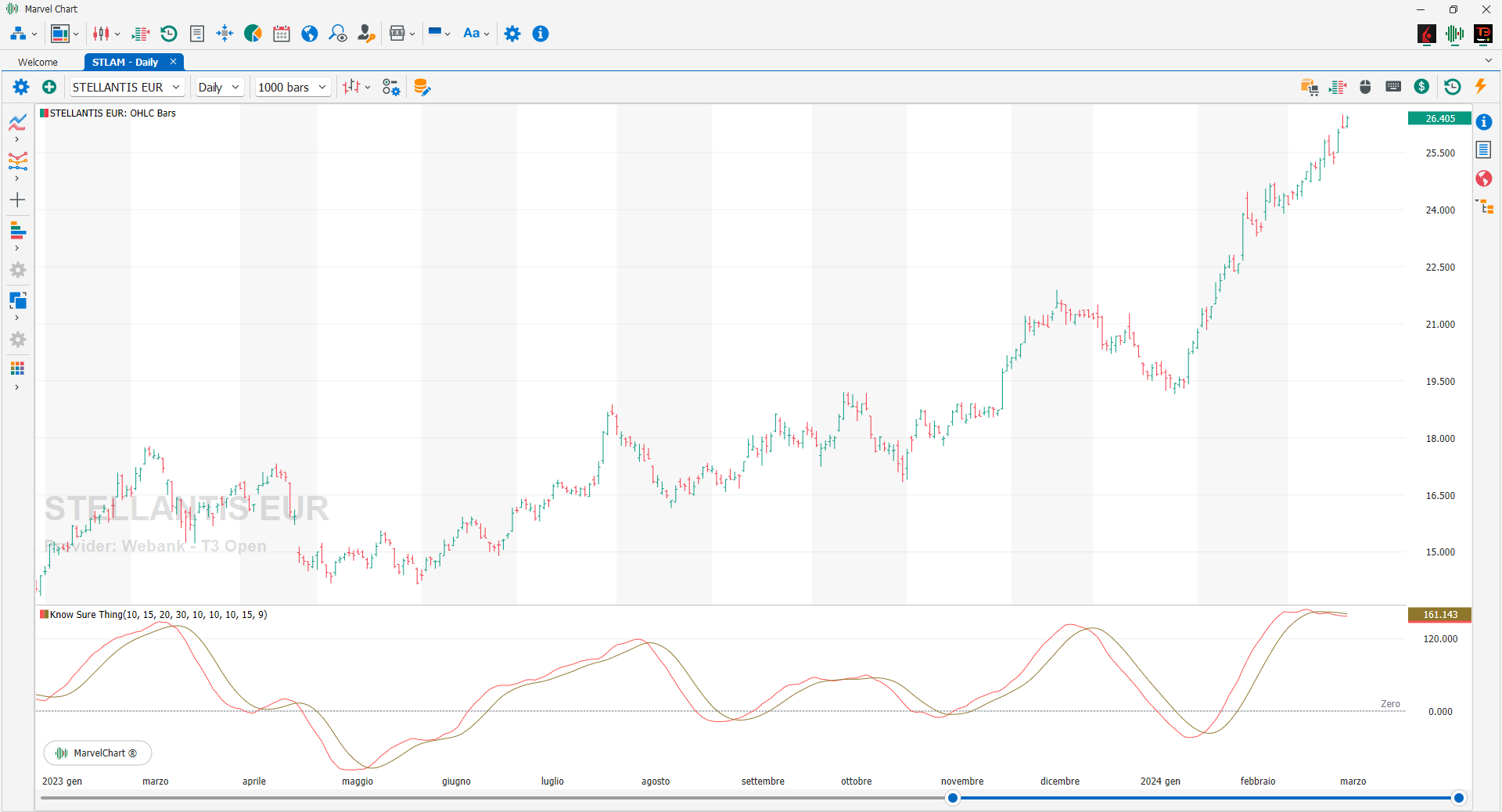
The Know Sure Thing indicator is a momentum-based oscillator and is based on the Rate of Change (ROC). The Know Sure Thing takes four different ROC time frames and smooths them out using simple moving averages, the Know Sure Thing then calculates a final value that oscillates between positive and negative values above and below a zero line. There is also a signal line that is an SMA of the KST line itself. In essence, the Know Sure Thing indicator measures the momentum of four separate price cycles. Technical analysts use this information to spot divergences, overbought and oversold conditions, and crossovers.
Momentum Oscillator
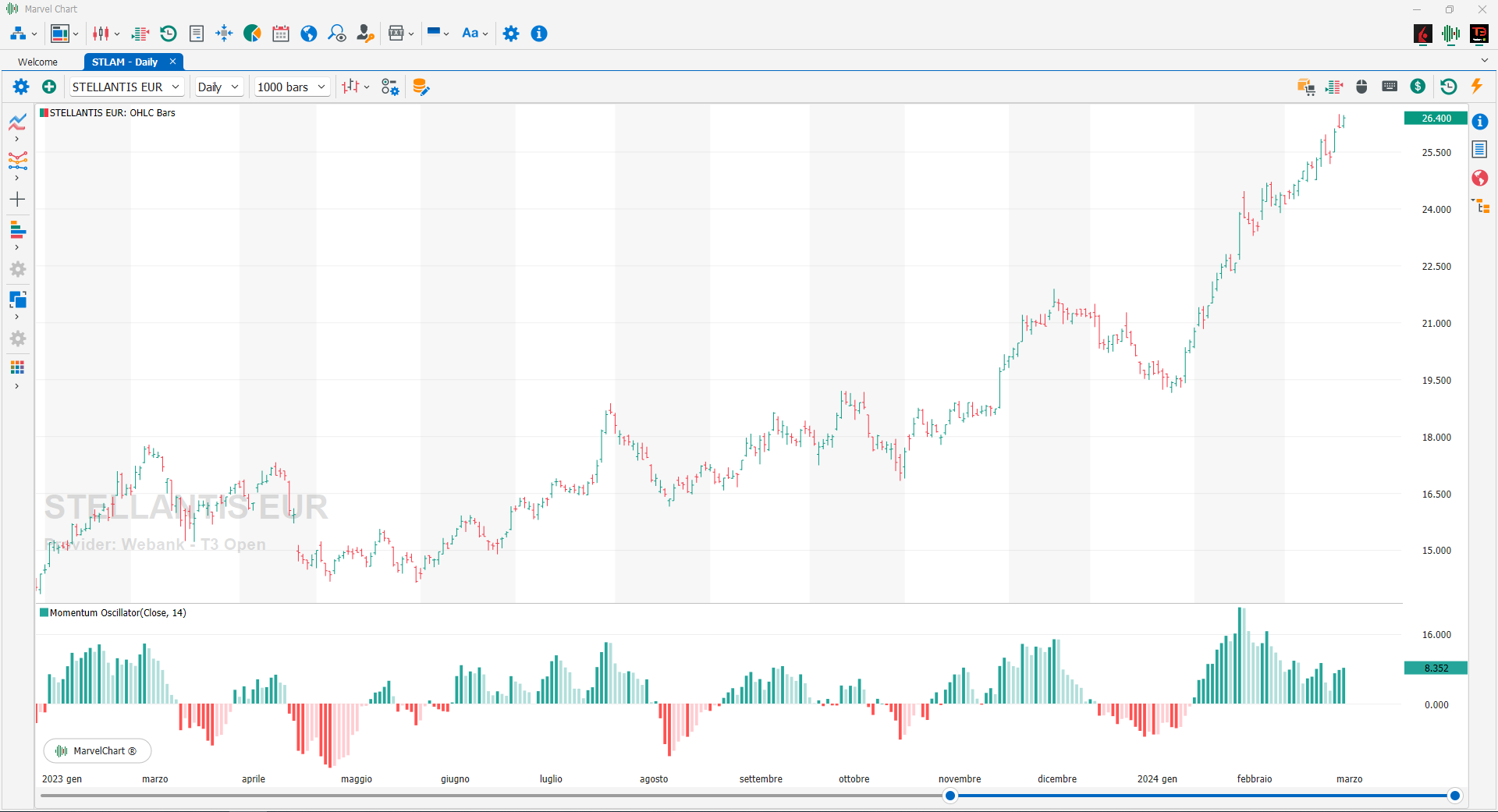
The Momentum Oscillator measures the strength of an asset by measuring the rate of change of prices compared to their actual levels. The calculation is performed on past data, as for all oscillators, recording the continuous variations of prices over pre-established time intervals. To construct the momentum lines of the X period it is necessary to subtract from the last CLOSE recorded, the CLOSE of X periods ago. A positive momentum value indicates that the current CLOSE is greater than the CLOSE of X previous periods, vice versa a CLOSE lower than that of X previous periods will consequently have a negative momentum value.
Premier Stochastic Oscillator
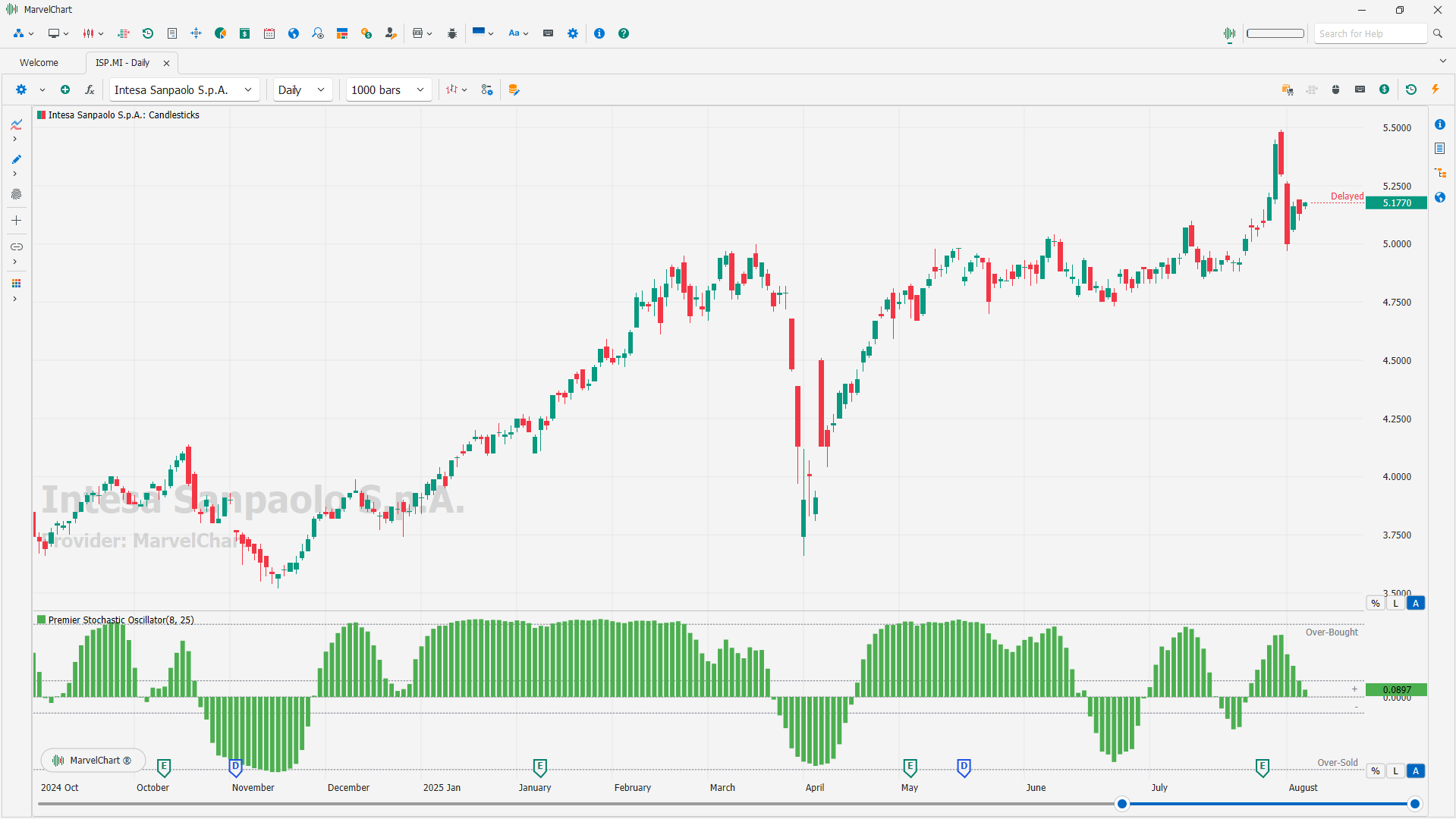
The Premier Stochastic Oscillator (PSO) indicator is a variation of the classic Stochastic Oscillator developed by Lee Leibfarth, featured in the August 2008 issue of Technical Analysis of Stocks & Commodities. It's designed to be more sensitive to short-term price movements by using a normalized output between -1 and 1 and incorporating a central zero line. This allows for earlier identification of potential trend reversals compared to the standard stochastic.
Key Features
Rewired Stochastic
The PSO is a modification of the standard Stochastic Oscillator, making it more responsive to price changes.
Normalized Output
It uses a range between -1 and 1, with 0 representing a neutral point, unlike the standard stochastic which uses 0-100.
Sensitivity
This normalized output and the rewiring of the formula make the PSO more sensitive to short-term price fluctuations, enabling quicker identification of potential trend reversals.
Double Smoothing
It employs a double exponential moving average (EMA) to smooth out the indicator's output, providing a more even response to market turns.
How it Works
Oversold/Overbought Zones
Values close to -1 are considered oversold, suggesting a potential bullish reversal, while values close to +1 are considered overbought, indicating a potential bearish reversal.
Crossovers and Divergences
The indicator can be used to identify buy and sell signals based on crossovers of the %K and %D lines, as well as divergences between the oscillator and price.
Central Zero Line
The PSO's use of a zero line as a reference point allows for a clearer visualization of bullish and bearish signals, as the indicator oscillates above and below this line.
Interpretation
Trending Markets
In trending markets, the PSO can be particularly useful, with traders often focusing on crossovers and divergences within the trending direction.
Oversold/Overbought Signals
Traders can also use the oscillator to identify potential overbought and oversold conditions, looking for reversals when the indicator moves back towards the central zero line.
Summary
Pretty Good Oscillator
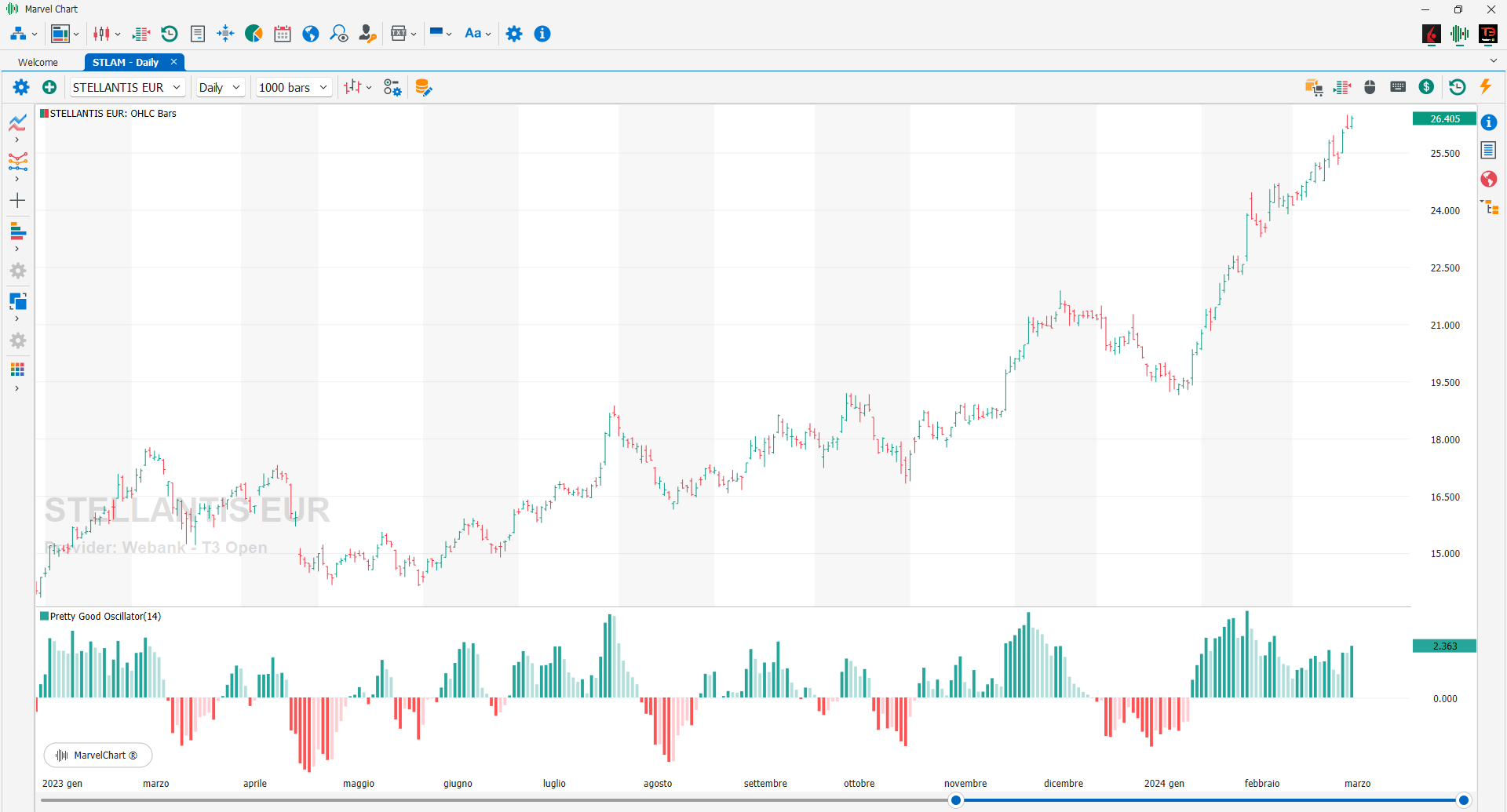
The Pretty Good Oscillator measures the distance of the current CLOSE from a moving average, divided by the Average True Range. The creator of the Pretty Good Oscillator, Mark Johnson, attributes the LONG signal if the indicator is above 2.5 and the SHORT signal on the indicator is below -2.5.
Price Oscillator
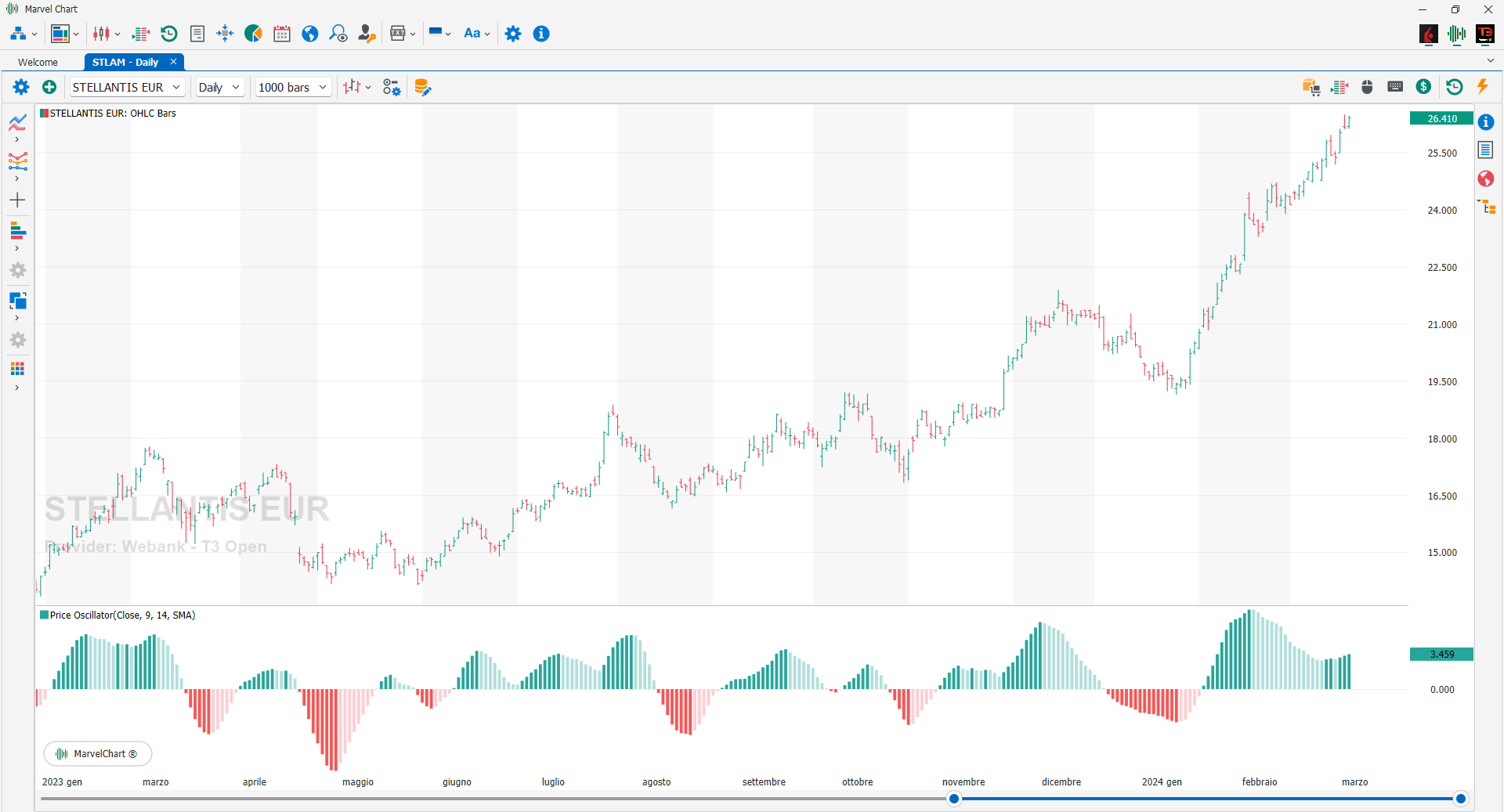
The Price Oscillator is a momentum indicator sometimes also identified as the “Moving Average Oscillator”, since it was built using two Moving Averages with different periods (Long Cycle and Short Cycle). The Price Oscillator measures the distance between the two moving averages; the Short Cycle is used to replace the price, the Long Cycle defines the trend. The greater the distance between the Short Cycle and the Long Cycle, the greater the value of the Price Oscillator and the greater the movement of the market.
Relative Strength Index Oscillator
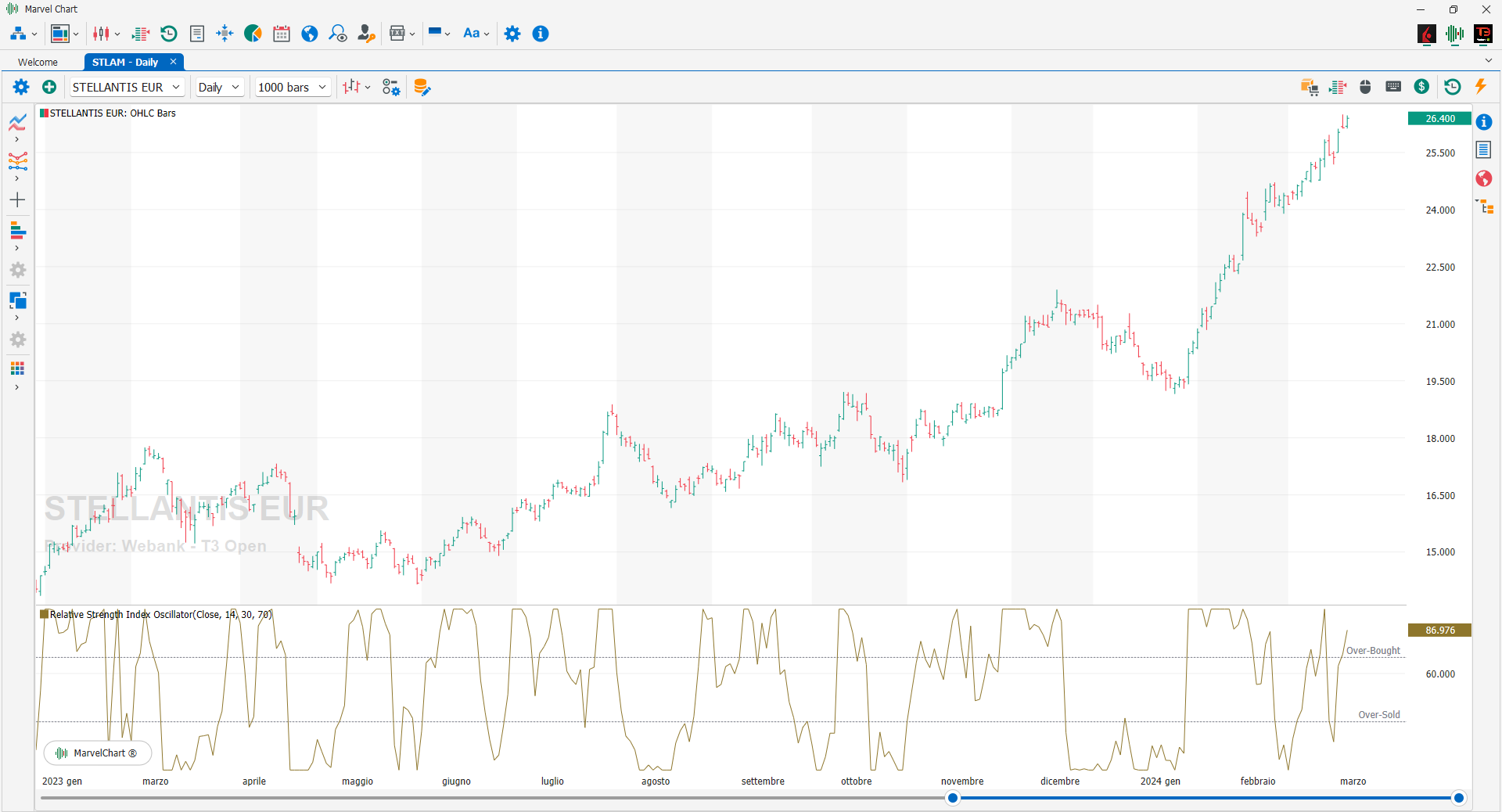
The Relative Strength Index Oscillator indicator converts the results of a regular Relative Strength Index indicator into an oscillator, effectively expressing RSI values as a percentage.
Stochastic Momentum Index Ergodic Oscillator
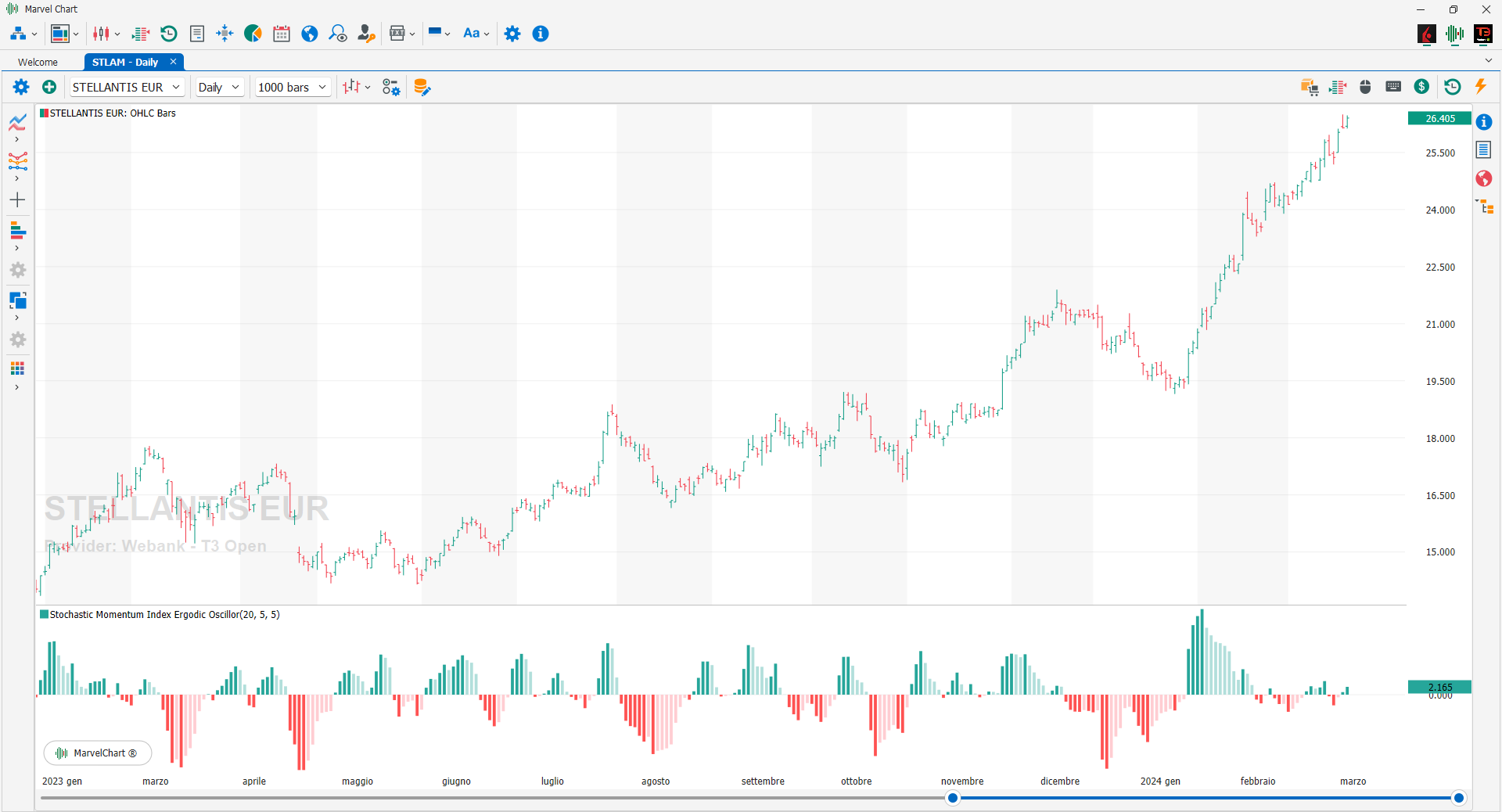
The Stochastic Momentum Index Ergodic Oscillator plots the difference between the Stochastic Momentum Index Erdogic and the signal line.
Stochastic Oscillator
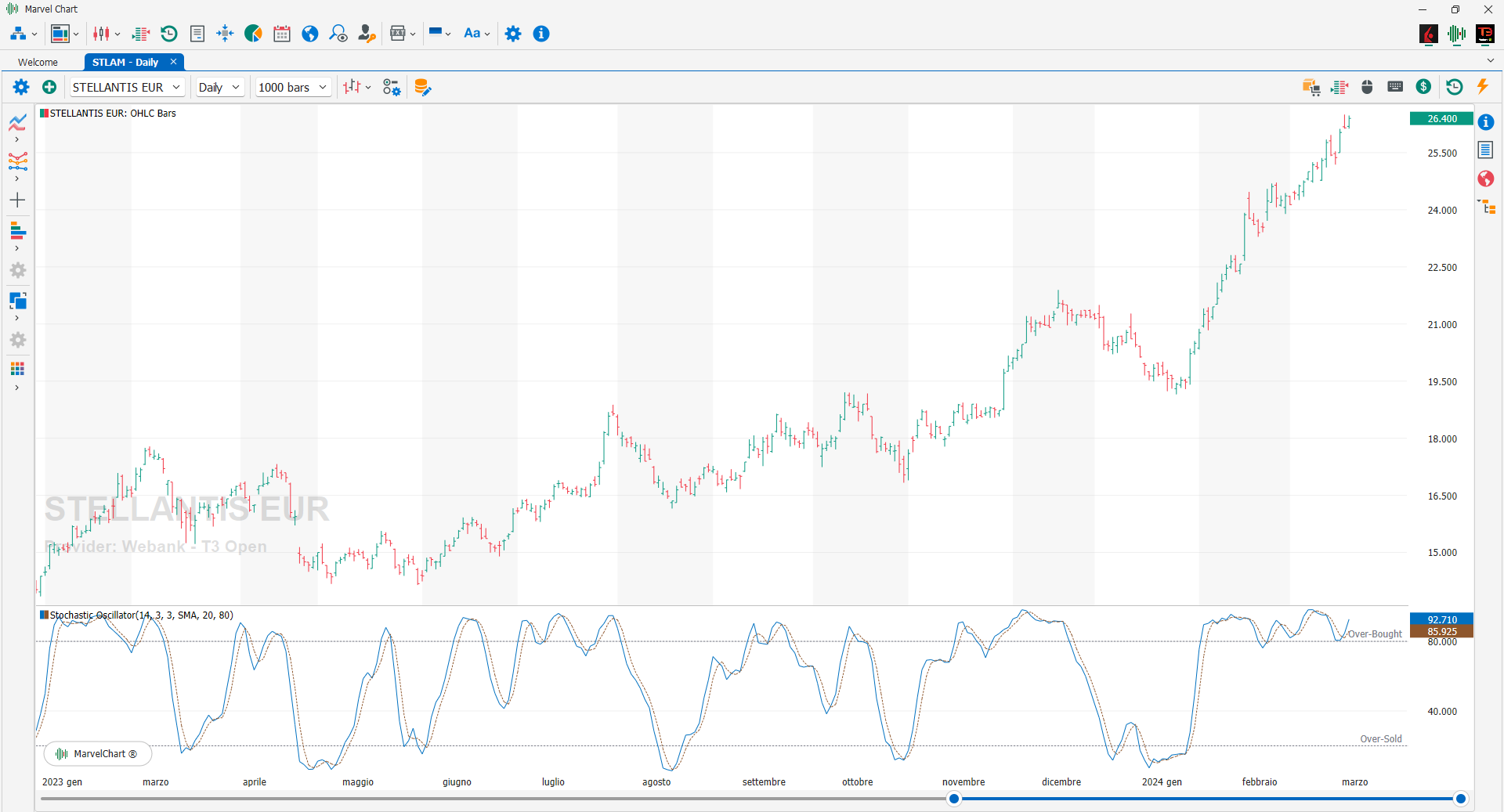
The Stochastic Oscillator, developed by George Lane in 1950, is a momentum indicator, an oscillator that relates the current CLOSE to the HIGH-LOW interval of a given period of time. This oscillator varies from 0 to 100, measuring the relative position of the current CLOSE, compared to the CLOSE of a given previous period. A value close to 0 indicates that we are close to the lows of the period considered (oversold area), on the contrary when the indicator is close to 100 it indicates that we are close to the highs of the period considered (overbought area). Therefore, if we are in an uptrend, the Stochastic Oscillator should be positioned at the maximum levels of the range, around 100, near 0 if we are in a bearish phase.
If the Stochastic Oscillator is between 0 and 20, it could indicate the continuation of the downtrend, on the contrary, when we see an overcoming of the horizontal line positioned at 20, we can expect a trend reversal, if it is between 20 and 80, we generally evaluate the continuation of the trend until it approaches the 80 threshold, if it is between 80 and 100, it indicates an uptrend with prices approaching new highs, a reversal could be a cut of the horizontal line at the 80 level downwards.
Twiggs Money Flow
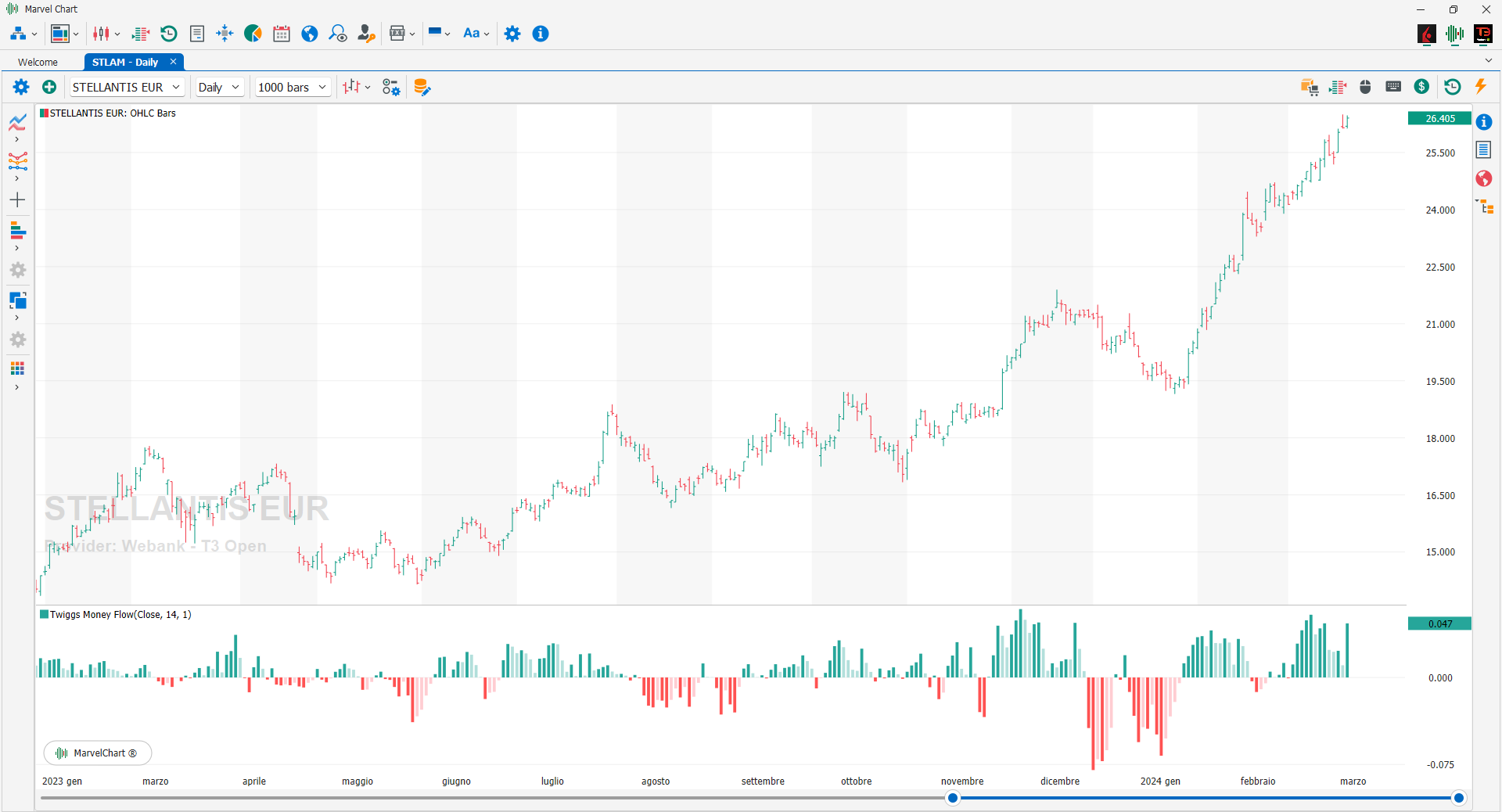
The Twiggs Money Flow is a variant of the Chaikin Money Flow, created by Colin Twiggs. Compared to Chaikin Money Flow, it uses the True Range instead of the HIGH-LOW range, thus limiting the peaks due to gaps in financial instruments. A Welles Wilder Smoothing is also used on volumes to prevent VOLUME peaks from influencing the result. When the Twiggs Money Flow is higher than 0, we are in an accumulation phase, and therefore prices will tend to rise. When Twiggs Money Flow is lower than 0, we are in a distribution phase and prices will tend to move downwards.
Two-Pole Oscillator
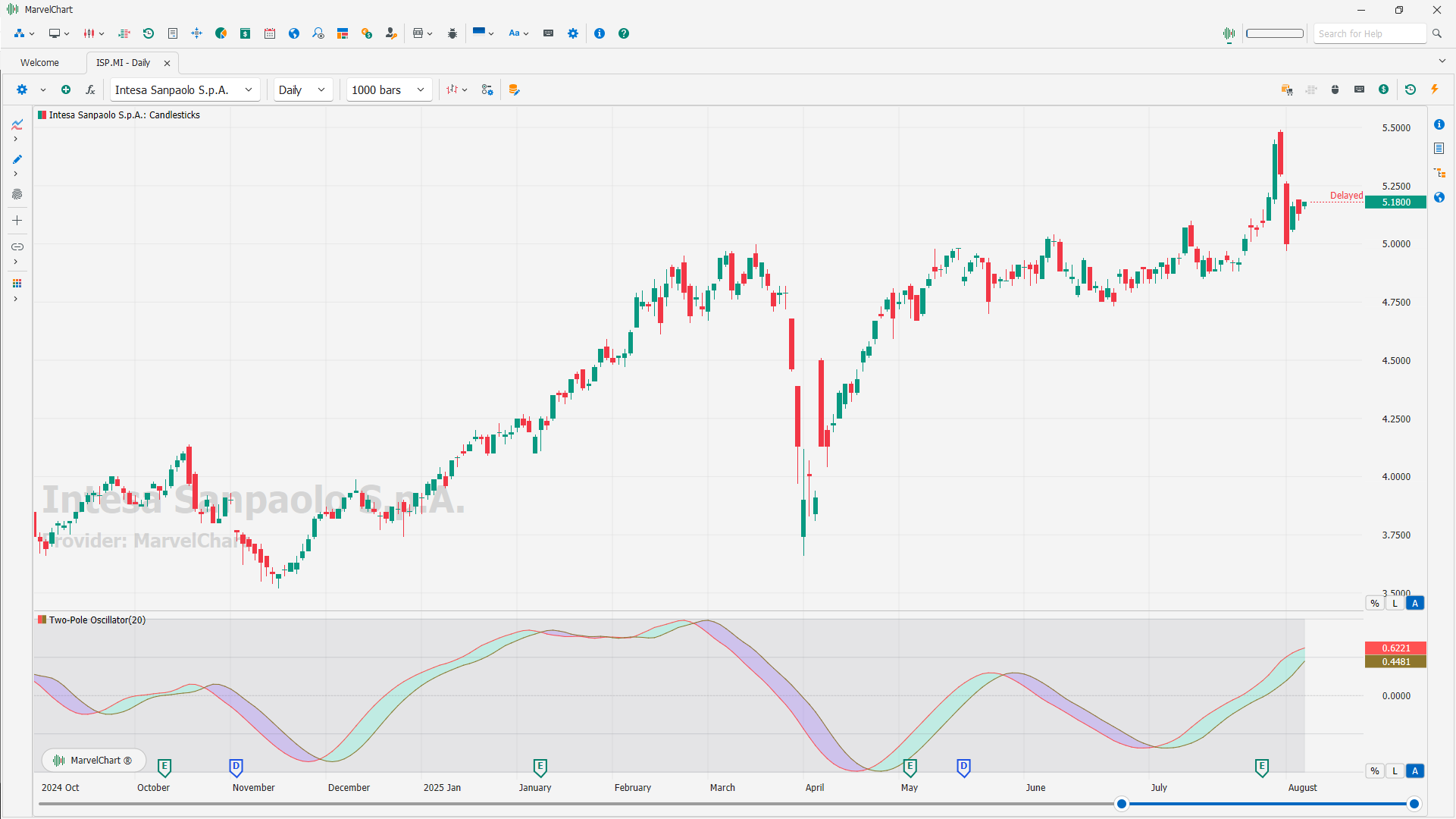
The Two-Pole Oscillator is an advanced smoothing oscillator designed to provide traders with precise market signals by leveraging deviation-based calculations combined with a unique two-pole filtering technique. It offers clear visual representation and actionable signals for smart trading decisions.
Ultimate Oscillator
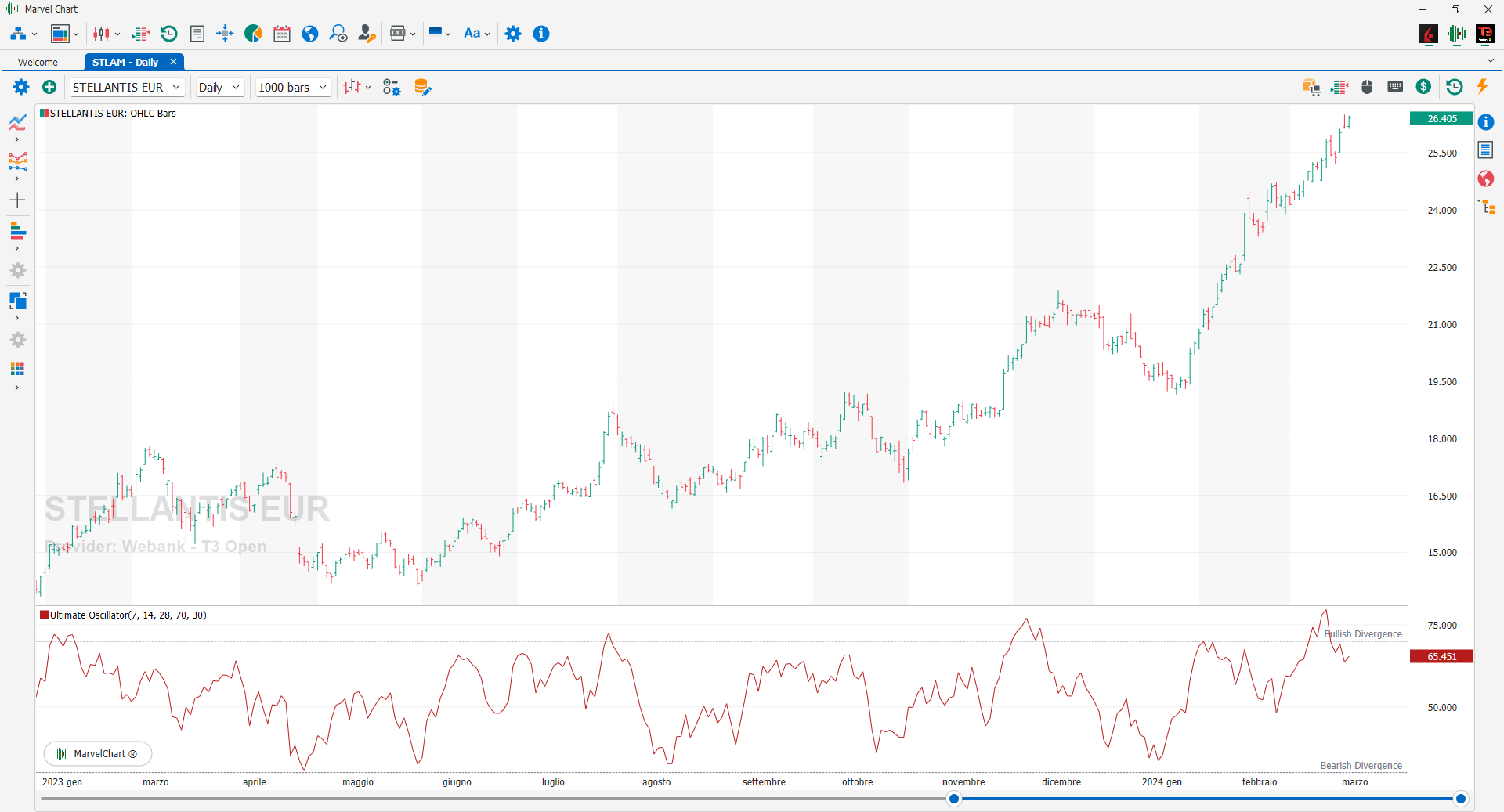
The Ultimate Oscillator combines price action in 3 different types of periods, and aims to define with greater force the possibility of trend reversal. The calculation with which it was defined is based on the current LOW and the CLOSE of the previous day. From here a pressure quotient is developed that intersects with the daily True Range. Then the pressure quotients of the 3 timeframes are added, the True Range of the 3 timeframes and finally the index comes out. The time periods used are representative of the short, medium and long-range phases, for a more in-depth calculation and estimate of a simple oscillator. Usually the periods used are 7-14-28. Another peculiarity is related to the overlap: all 3 periods are included in the calculation, so the 28-time frame also includes the 14th and the 7th.
Wave Trend Oscillator
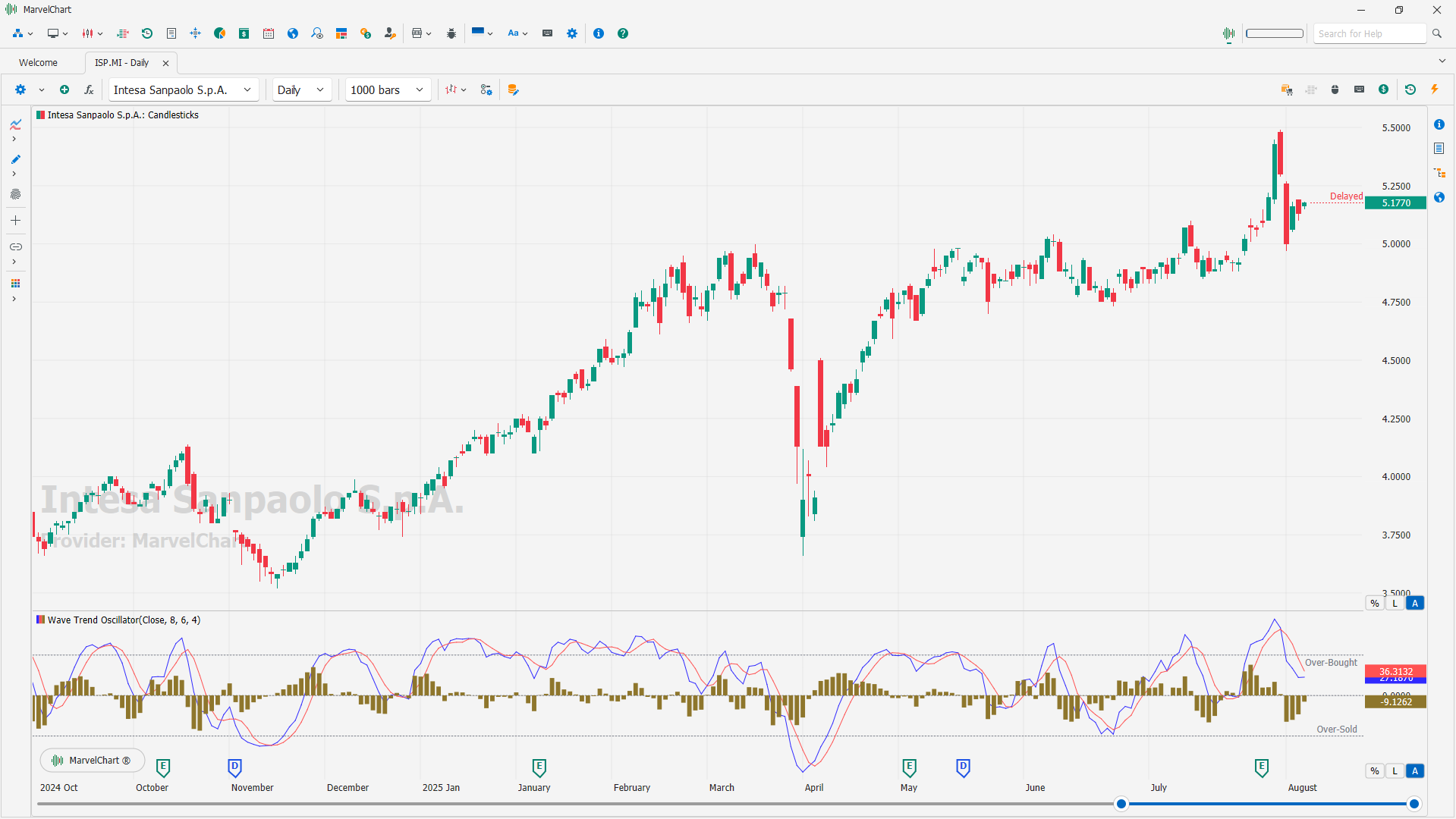
The Wave Trend Oscillator (WT) is a momentum-based technical indicator that helps traders identify overbought and oversold conditions in the market. It utilizes two moving averages to smooth price data and detect potential trend reversals and divergences.
How it works
WT Line
The main oscillator line, which reflects price momentum and direction.
Signal Line
A smoothed version of the WT line, used to generate buy and sell signals.
Divergence
When the WT Line and price action move in opposite directions, it can signal a potential trend reversal.
Crossovers
When the WT Line crosses above the signal line, it suggests bullish momentum, and when it crosses below, it indicates bearish momentum.
Overbought/Oversold Levels
The indicator includes overbought and oversold levels, with default values set to +60 and -60, respectively. These levels help identify potential areas where the trend may reverse.
Key Features and Signals
Trend Identification
The WT Line and signal line crossovers help identify the overall trend direction.
Potential Reversals
When the WT Line crosses below the signal line from overbought levels or above the signal line from oversold levels, it can signal a potential trend reversal.
Divergence Detection
Bearish divergence occurs when price makes a lower low, but the WT Line makes a higher low, suggesting weakening bearish momentum. Bullish divergence occurs when price makes a higher high, but the WT Line makes a lower high, suggesting weakening bullish momentum.
Take-Profit Zones
The indicator can also be used to identify potential take-profit zones by analyzing the overbought and oversold levels, and by observing the movement of the WT Line in relation to the signal line.
Summary
Williams %R
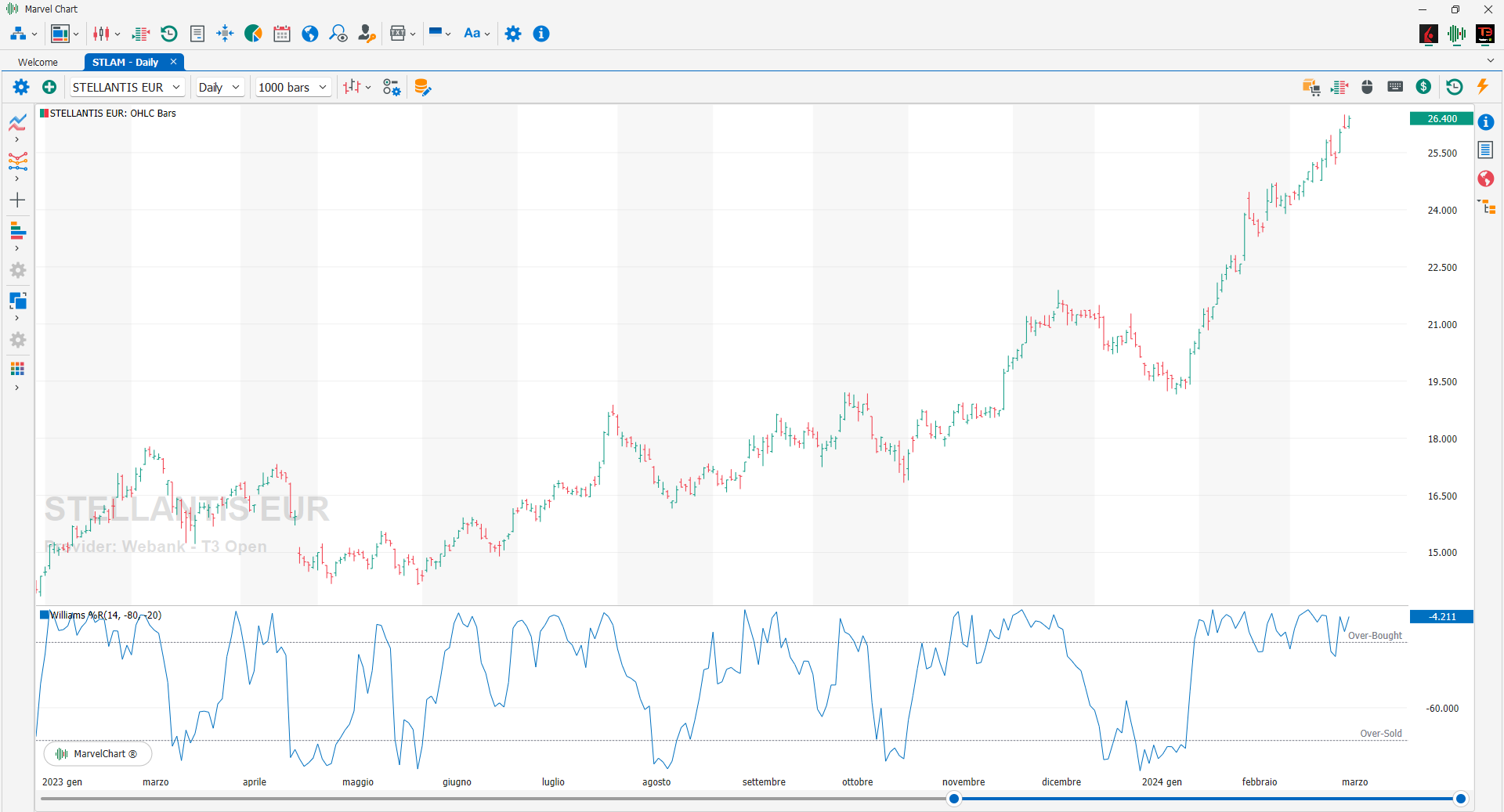
Williams %R is an indicator developed by the famous American trader Larry Williams, which oscillates between 0 and -100, practically on an inverted scale. Two extreme zones of the index are identified, but their reading occurs in a mirror manner to that of the stochastic itself. According to the author, the zones to monitor are -20 and -80. Values above -20 represent the overbought area, while values below -80 represent the oversold area. The buy signal is activated when the indicator, after falling into oversold (below -80), falls above this threshold. On the contrary, the sell signal will start when the indicator in the overbought zone (above -20) falls and violates this threshold.